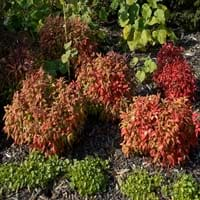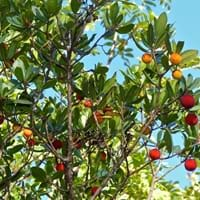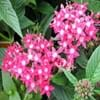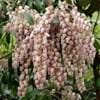Life Span
Perennial
Perennial
Type
Broadleaf Evergreen
Tree
Origin
China, Japan
Mediterranean
Types
Heavenly Bamboo, Nandina 'Colerno'
Dwarf Nandina 'Compacta'
Dwarf Nandina 'Filamentosa'
Heavenly Bamboo, Nandina 'Harbor Belle'
Heavenly Bamboo, Nandina 'Moon Bay'
Not Available
Number of Varieties
Not Available
Habitat
low mountains, Mountain tops, Mountains, Valley
limestone outcrops, Rocky areas, Woodlands
USDA Hardiness Zone
6-11
8-9
AHS Heat Zone
Not Available
9-6
Sunset Zone
21,22
8, 9, 14, 15, 16, 17, 18, 19, 20, 21, 22, 23, 24
Habit
Clump-Forming
Upright/Erect
Flower Color
Not Available
White, Light Pink
Flower Color Modifier
Bicolor
Bicolor
Fruit Color
Not Available
Yellow, Red
Leaf Color in Spring
Green, Purple, Copper
Dark Green
Leaf Color in Summer
Green, Purple
Dark Green
Leaf Color in Fall
Green, Purple
Dark Green
Leaf Color in Winter
Red, Green, Purple
Dark Green
Leaf Shape
Acuminate
Orbiculate
Plant Season
Spring, Summer, Fall, Winter
Spring, Summer, Fall, Winter
Sunlight
Full Sun, Partial Sun, Partial shade, Full Shade
Full Sun, Partial Sun
Type of Soil
Loam, Sand
Loam, Sand
The pH of Soil
Acidic, Neutral, Alkaline
Acidic, Neutral
Soil Drainage
Well drained
Well drained
Bloom Time
Not Available
Spring, Late Spring, Early Summer, Summer, Late Summer, Early Fall, Fall, Late Fall
Tolerances
Drought
Drought
Where to Plant?
Ground
Ground
How to Plant?
Seedlings
Seedlings
Plant Maintenance
Medium
Medium
Watering Requirements
Do not water frequently, Needs less watering
Requires regular watering
In Summer
Lots of watering
Lots of watering
In Spring
Moderate
Moderate
In Winter
Average Water
Average Water
Soil pH
Acidic, Neutral, Alkaline
Acidic, Neutral
Soil Type
Loam, Sand
Loam, Sand
Soil Drainage Capacity
Well drained
Well drained
Sun Exposure
Full Sun, Partial Sun, Partial shade, Full Shade
Full Sun, Partial Sun
Pruning
Remove damaged leaves, Remove dead branches, Remove dead leaves
Prune in early spring, Prune in late winter, Remove damaged leaves, Remove dead branches, Remove dead leaves
Fertilizers
All-Purpose Liquid Fertilizer
All-Purpose Liquid Fertilizer
Pests and Diseases
Red blotch
Red blotch
Plant Tolerance
Drought
Drought
Flowers
Not Available
Showy
Flower Petal Number
Not Available
Single
Foliage Texture
Fine
Medium
Foliage Sheen
Glossy
Glossy
Attracts
Mealybugs, Whiteflies
Hummingbirds
Allergy
Not Available
Hay fever, Oral Allergy, Skin irritation
Aesthetic Uses
Bonsai, Borders
Beautification, Showy Purposes
Beauty Benefits
Not Available
Not Available
Environmental Uses
Air purification
Air purification
Medicinal Uses
Antirheumatic, Antitussive, Astringent
Antioxidants
Part of Plant Used
Fruits, Leaves
Fruits
Other Uses
Used for making informal hedge
Traditional medicine, Used As Food, Used as Ornamental plant, Used for its medicinal properties
Used As Indoor Plant
No
Yes
Used As Outdoor Plant
Yes
Yes
Garden Design
Container, Edging, Foundation, Groundcover, Hedges, Mixed Border, Topiary, Bonsai, Espalier
Shade Trees, Street Trees
Botanical Name
NANDINA domestica 'Nana Purpurea'
ARBUTUS 'Marina'
Common Name
heavenly bamboo
sacred bamboo
nandina
Marina Strawberry Tree, Strawberry Tree
In Hindi
Dwarf Nandina
झरबेरी पेड़
In German
Dwarf Nandina
Erdbeerbaum
In French
Nandina Dwarf
arbousier
In Spanish
Nandina enana
Árbol de fresa
In Greek
Dwarf Nandina
φράουλα δέντρο
In Portuguese
Nandina do anão
medronheiro
In Polish
Dwarf Nandina
Strawberry Tree
In Latin
Dwarf Nandina
arbutus
Phylum
Tracheophyta
Magnoliophyta
Class
Magnoliopsida
Magnoliopsida
Order
Ranunculales
Ericales
Family
Berberidaceae
Ericaceae
Clade
Angiosperms, Eudicots
Angiosperms, Asterids, Eudicots
Tribe
Not Available
Not Available
Subfamily
Not Available
Not Available
Number of Species
Not Available
Not Available
Season and Care of Dwarf Nandina and Strawberry Tree
Season and care of Dwarf Nandina and Strawberry Tree is important to know. While considering everything about Dwarf Nandina and Strawberry Tree Care, growing season is an essential factor. Dwarf Nandina season is Spring, Summer, Fall and Winter and Strawberry Tree season is Spring, Summer, Fall and Winter. The type of soil for Dwarf Nandina is Loam, Sand and for Strawberry Tree is Loam, Sand while the PH of soil for Dwarf Nandina is Acidic, Neutral, Alkaline and for Strawberry Tree is Acidic, Neutral.
Dwarf Nandina and Strawberry Tree Physical Information
Dwarf Nandina and Strawberry Tree physical information is very important for comparison. Dwarf Nandina height is 30.00 cm and width 60.00 cm whereas Strawberry Tree height is 1,220.00 cm and width 610.00 cm. The color specification of Dwarf Nandina and Strawberry Tree are as follows:
Dwarf Nandina flower color: Not Available
Dwarf Nandina leaf color: Green, Purple and Copper
Strawberry Tree flower color: White and Light Pink
- Strawberry Tree leaf color: Dark Green
Care of Dwarf Nandina and Strawberry Tree
Care of Dwarf Nandina and Strawberry Tree include pruning, fertilizers, watering etc. Dwarf Nandina pruning is done Remove damaged leaves, Remove dead branches and Remove dead leaves and Strawberry Tree pruning is done Prune in early spring, Prune in late winter, Remove damaged leaves, Remove dead branches and Remove dead leaves. In summer Dwarf Nandina needs Lots of watering and in winter, it needs Average Water. Whereas, in summer Strawberry Tree needs Lots of watering and in winter, it needs Average Water.





